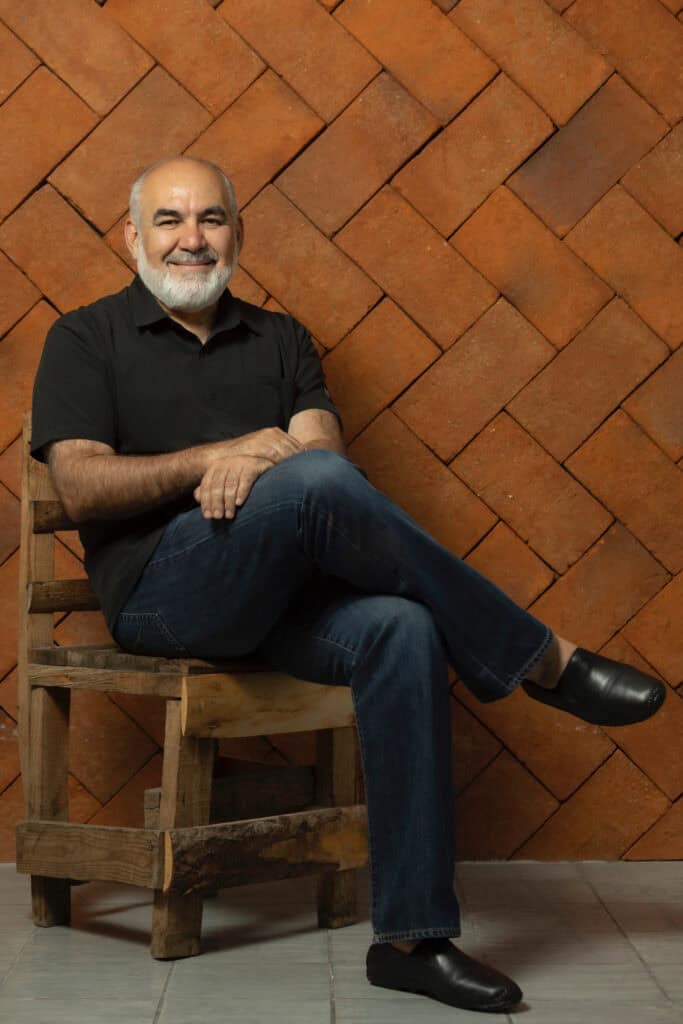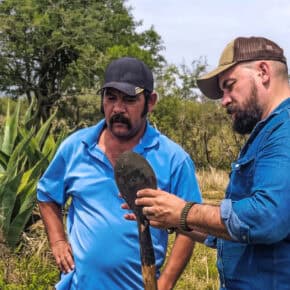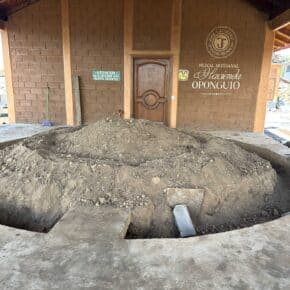Few others have a history as storied as David Suro in the craft Mexican food and agave spirits industries in the United States. From his renowned Philadelphia restaurant, Tequilas, to the Tequila Interchange Project, to his Siembra Spirits, his portfolio of imported agave spirits, and his recent book publication, Suro has been a powerful force driving forward the status quo of Mexican culture in the United States, and an invaluable mentor to so many of us involved in the related industries. While his many projects are too vast to capture in any single article or interview, here we dive into some personal history, highlighting how Suro’s unique path and passions brought him to initiate and sustain the many efforts he is known for today.

Where did you grow up?
Guadalajara is home…I think I was around 20 years old when I moved out of Guadalajara. I moved to Cancun and worked there for three years. I met my first wife, Annette, in Cancun; she was a native of Philadelphia and when we were expecting our first kid, David Jr., we decided to come to Philadelphia. I arrived in the United States when I was 22 or 23, and I’ve been here ever since, that was in 1985.
Where and what did you study?
I went to school in Guadalajara, up to my first year of administration, then I dropped out and moved to Cancun.
What was your first job?
When I was a young kid, my mother used a travel agency to send me to Disneyland (against my will!) I was not interested at all to go to Disneyland because I had a little puppy and I was not happy to leave my little dog for 10 days. When I came back I asked if I could work in the travel agency and that ended up being my first job. After that I worked in a bank.
When I eventually arrived in Cancun I worked in the restaurant industry, a group of restaurateurs that were very well-known and respected, they had restaurants all over Mexico; it was called the Anderson Group. That was my alma mater for my love for the restaurant industry. I started with bussing and dishwashing, you know the typical entry level positions in the old school restaurant industry. Then I graduated to waiter, then a little bit of management until I migrated. I pretty much went through the process of the old school restaurant industry, you learn from the bottom up.
In an amazing way, it was a very tough school with lots of discipline. The group was very well known all across Mexico for its uniqueness and high standard of service and amazing atmosphere; truly I found something that I wanted to do for the rest of my life which was to be in the food and beverage industry. It was thanks to the way that this company helped me to walk through this industry, with a great deal of discipline and creativity and originality and very high standards.
That was the paradise of Cancun, the golden age of Cancun. It was still very focused on eco-tourism and natural beauty, appreciation for more natural things than the big mess and big noise that is Cancun right now. It’s very painful to see where Cancun is nowadays, because it was a true paradise back then. It was not very easy to get there, and there was a different approach to tourism. In the mid 90s was when the big all inclusive new concept started to bring massive tourism with the consequences of mass activity and the impact of the culture and ecosystems, and that paradise was lost in a lot of ways. That was Cancun at its prime, and it paid the price of its success. Which is what we’re seeing a lot of today’s agave culture, the parallels are scary.
What do you think of the Tren Maya?
I’m not against it…I am optimistic. The southern part of Mexico has been in many ways isolated and the infrastructure may promote not just tourism but movement among communities and people. It’s a little bit too early to judge if it’s good or bad. Obviously there is an ecological impact- having to open room to develop railways, I think the impact that project really has on the ecosystems has been exaggerated…it’s necessary, we cannot deny this access and infrastructure and communications to that part of Mexico. Time will tell us if it was good or bad.
Tell me about Tequilas and how it all started.
When I moved here [to Philadelphia] the original idea was to come here during the pregnancy and after the baby was born we were going to go back to Cancun because we were doing well down there. It was a very promising future in the company where I was working and I really wanted to go back and continue my participation in that company. But the first couple of months I was here, I started to work in a Mexican restaurant. I wanted to learn more about the industry and how it worked in the United States. I thought it was a great opportunity. During that period of time I met people that saw there was a great opportunity for me to open a restaurant in Philadelphia, a Mexican restaurant because true Mexican restaurants were not such a thing in Philadelphia or the northeast in general.
I worked on a business plan that was to help minorities to start businesses, we started to work on the possibilities and it became something that was very possible to do. We applied for loans in 1985/86, but there was a big recession and all the plans and programs we had went south, we were not able to get financing. We went through private banking to get some loans and they were not going to lend money to a 24 year old kid who didn’t even know how to speak English. It was my father in law who one day grabbed me and said you really know what you’re doing, I don’t have the money but I can cosign and with his help we got an $85,000 loan. The owner of the Mexican restaurant where I was working had plans to retire and move out of Philadelphia, so he offered to sell the restaurant to me, so we used that loan to buy the restaurant and transform it into what became a very interesting proposition.
Culinarily and culturally speaking we introduced a cuisine that was not seen in this part of the country before. Back then, in the 1980s, only New York and Chicago for the northern part of the United States offered authentic cuisine. Rosa Mexicana by Josefina Howard, and Rick Bayless in Chicago were the only concepts in the northeast that served pipian, mole, cochinita pibil, all these propositions that were really focused on real Mexican food. So that is what Tequilas became, this restaurant in downtown Philadelphia that offered a very original Mexican menu and also tried to focus on not just culinary but the spirits aspect of what Mexico was truly all about. So there it was, Tequilas was born 1986.
What was your introduction to mezcal?
Being from Guadalajara, and considering the historical context of mezcal…unfortunately we did not have access to traditional mezcal like we do today. The only thing that was available in the United States and Guadalajara was mezcal with the worm in it. Mezcal was…let’s just say I understand why the perception of tequila was better. But even the tequilas available in the United States were mixtos, the access to tequila was of very questionable quality. So my introduction was not good, it was not until I did my own research and traveling and talking to the very few academics that were focused on the research of agave spirits and tequila, when I started to figure out that there was another side of mezcal and tequila. Just like the other side of Mexican food, it’s not all chimichangas or taco salads, or alcohol stuff with the worm in it. I started to figure out there were such beautiful cultural elements to discover, and that was when I started to get more interested in learning and visiting maestros mezcaleros as well as maestros tequileros. I was introduced by studying tequila- if you really focus on what tequila is all about, you cannot avoid getting into mezcal. Today it’s a whole different approach.
Who was the first maestro mezcalero you visited?
It was somebody from the southern part of Jalisco, during an expedition that we had, we got lost in the southern part of Jalisco and we found these maestros that were doing amazing things, working with agaves in a whole different approach. That’s where I sparked my curiosity on the origins of distillation. When you start to question what is really the origin of distillation in mesoamerica, you see the Spanish introduced alembics, but they have nothing to do with the Filipino distillation. Meeting these maestros, instead of answering questions you have more questions.
You do so many things in the agave industry, how do you describe your role?
All these experiences I have been having through the years and all these amazing people and mentors I’ve been lucky to work with, my role is just to echo their stories and share the journeys that I’ve been lucky to have. I don’t consider myself an educator or anybody but a very enthusiastic agave spirits person that feels there is so much to share. I try to be a voice for those people who have not been on our radars as consumers. I feel it is necessary to echo their voices and codify some of the cultural barriers between producers and consumers. To try to diminish the distractions between the real cultural elements and the marketing distractions.
Who have been some of the most influential people on your mezcal journey?
There are so many, I dont think it’s one specific person. I do have my beginnings with the Camarena family, Don Felipe, Carlos, Fernando Gonzales from Siete Leguas, they are guys who have a tremendous amount of pride and integrity that I admire a lot, and on top of that they are amazing agave spirits producers. Professors like Salvador Gutierrez, Rodolfo Fernandez, Ana Valenzuela, my co writer Gary Nabhan, and Patricia Colunga. Thomas Estes was another person that I came across years ago and who also helped me to understand we were not alone in trying to send the message across the world. It was a tremendous amount of inspiration to meet Thomas Estes. You know I walked into the tequila category when I was 17 years old without knowing I would do this for the rest of my life. The Rosales family was my first contact, physically, in the 1970s, at Cascahuin. There were lots of people who were generous with me. Don Julio Gonzales is another person who allowed me to get under his wing. Later on the producers I worked with were another group of people who were of tremendous inspiration and mentorship. Don Japo, Don Jorge Perez, Don Emilio Vieyra, Don Lorenzo Virgen. On this journey you meet so many people all around the world who are restaurateurs and bartenders, I’ve learned so much from them all.
Any favorite lessons you’ve learned from mezcal producing communities?
How humble they are…their humility and perseverance. If we put into historical context for all these producers to be able to survive generations of incredible classism and racism and not being taken seriously and subdued, and they are still humble and open, that is the resilience of these people, that is what I admire the most. It’s something you notice in families that still operate tequila distillers. There is a tremendous amount of pride, and at the same time a tremendous amount of humility. You see guys like the Camarenas and Fernando Gonzales, or the many mezcaleros, and you see what they are going through and still doing incredible work and don’t give up, it’s amazing. It’s very easy to say but very difficult to practice. These people have been doing it for generations.
What are some of the contributions to the industry that make you most proud?
Our Ancestral bottling holds a very special place in my heart. Introducing it to the market took me more than 20 years, developing that expression of tequila that goes back to our humble roots of vino de mezcal de tequila. That is an expression that really has a lot of meaning to me. We want to reconnect the roots of tequila with the roots of mezcal. For generations that’s been something that is missing. We think tequila then we think mezcal, without really connecting the dots. To be able to introduce Siembra Valles Ancestral eight years ago is something that brings a big smile to my face. It took a couple of years for even people who really understand agave spirits to get it, they were having challenging feelings about a tequila produced in this original way. That project is something that is very important for me personally and the category.
We are also about to launch a new project which is extremely meaningful. After more than 30 years knowing the Camarena family I approached Carlos and his sisters and I never felt I deserved the privilege to ask them if I could have an expression of Siembra produced at La Alteña. I was happily surprised and humbled when he said ‘why didn’t you ask before David!’ We are about to launch an expression that is produced at La Altena: Siembra Alteño. That is an incredible privilege and responsibility for our project to carry the name of the Camarenas. It took more than 30 years to have the guts to ask them if I could produce in their facility and I am excited to announce the launch. Production is complete, the line includes a high proof blanco at 46% abv and a reposado and añejo.
What’s on the horizon, what are you excited about looking forward?
Reopening the restaurant! Being able to do what we did in the beginning. The restaurant was the showcase, where we can perform and talk and attract people to tell the story and share the stories. I cannot wait to reopen the restaurant and put the lights on the stage of agave spirits and the food again. I really need it. During this year that we’ve been closed I learned how much I love what I do and how much I miss it.












Leave a Comment